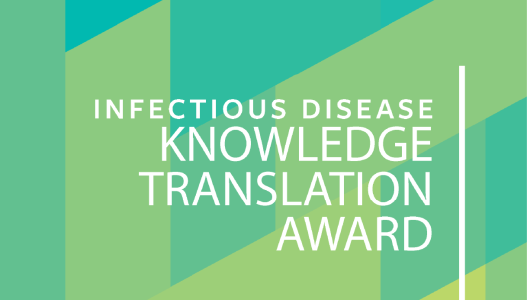
Influenza and influenza-like illnesses (ILI) are persistent public health problems due to seasonal influenza (the flu) and other respiratory pathogens as well as emergency pandemic situations.
NCCID shares knowledge about surveillance methods, estimates of the burden of influenza, the effectiveness of vaccines and other prevention strategies, and equitable delivery of services. Public health problems seen during flu season and in pandemics, as well as their solutions, are part of the mandates of all the National Collaborating Centres for Public Health (NCCPH), making influenza and influenza-like illness an important area for collaboration.
What’s New
NCCID and CFID Infectious Disease Knowledge Translation Award
NCCID and CFID offer the Infectious Diseases Knowledge Translation Award to encourage student involvement in knowledge translation and health promotion on preventing and controlling infectious diseases. Applications accepted until January 13, 2023
Sustaining a Voice for a Silent Public Health Crisis: World Antimicrobial Awareness Week 2022
Antimicrobial Awareness Week (formerly Antibiotic Awareness Week), November 18 – 24, promotes informed, careful use of these life-saving medicines to help keep them working for future generations.
Iconic buildings and landmarks Go Blue for antimicrobial resistance throughout Canada
Canadian buildings and landmarks are sparking up in light blue on Thursday, November 24th, to mark the close of World Antimicrobial Awareness Week. The World Health Organization (WHO) has declared antimicrobial resistance (AMR) as one of the top 10 global health threats.
2021 One Health Antimicrobial Stewardship Conference Final Report
The report summarizes the key concepts of each presentation and discussion panel, from the One Health Antimicrobial Stewardship Conference, hosted by the ABVMA March 10-12, 2021.
A look at the global vaccine rollout for COVID-19
The Coronavirus disease (COVID-19) is a global pandemic as announced by World Health Organization (WHO, March 11th 2020). It is…
Glossary of Terms: Understanding the Regulatory Review of Drug Therapies
NCCID has assembled a glossary of terms related to regulatory processes for ensuring the safety and efficacy of drug therapies, including new drugs and new therapeutic applications for existing drugs. The aim is to increase understanding of these terms and transparency on related policies that protect Canadians.
Resources
Identifying the Gaps
NCCID led a two-year collaborative project that brought together the expertise of the six NCCs to respond to recognized knowledge gaps regarding the prevention and control of influenza. Together, the NCCs developed a suite of new knowledge products to address these and other issues.
NCCID and its partners asked public health stakeholders, what are the priorities and what types of knowledge projects are most useful?
The themes and questions most often mentioned were Vaccines effectiveness, Primary prevention, Rapid diagnostics, Surveillance & burden of illness, Communication & messaging, and Equity. Learn more about each theme here.
The National Collaborating Centre for Infectious Diseases conducted several projects to strengthen the evidence-base and methods used to support public health decisions on when, among whom, and how best to intervene, particularly to avoid severe outcomes of influenza.
Vaccine Effectiveness
NCCID commissioned two reviews of evidence on the effectiveness of vaccines for seasonal influenza, as part of this collaborative project.
The first reviewed the mid-season results for vaccine during the 2013-14 flu season. Such a review may seem to be time-limited, but as Dr. Heejune Chang comments, there is considerable long-term value for public health personnel and decision-makers.
NCCID also commissioned Dr. Salah Mahmud and his team from the University of Manitoba’s Centre for Pharmacoepidemiology and Vaccine Research to conduct a systematic review of evidence on the effectiveness of seasonal influenza vaccines against influenza A (H1N1), post 2009-2010. The results of the systematic review (in press) have been submitted for review to the journal, Emerging Infectious Diseases. Here we provide you with the highlights of key findings.
Burden of Disease: Influenza
This project explores the conceptual and methodological groundwork to understand the true burden of disease, or of Influenza and ILI. As a first step, NCCID developed a primer on how burden is typically measured, as well as a Quick Reference on HALYS, DALYS AND QALYS.
Building on this work, NCCID developed ‘Framing Burden.’ We workshopped this exploration of a wider concept of ‘burden of disease,’ the scope of its application, and considerations for developing a broader, equity-informed framework for analysis at CPHA 2015.
Modeling Influenza
A logical framework for modelling influenza and a review of terms used in this field are the starting points of this work aimed at improving communication and collaboration among modellers, infectious disease epidemiologists, and public health planners. In the fall of 2014, NCCID hosted a workshop with the Pan-InfORM team. The workshop was very successful and led to the development of an online discussion group, mod4PH, to build on the work and on the new links between public health and research modellers.
School Closures
Public health decision makers regularly have to consider the possibility of closing schools during flu season or during a pandemic. NCCID conducted an updated evidence review on the effectiveness of school closures for the control of influenza. The review balances the evidence with the feasibility and ethical implications of the measure. NCCID also developed a policy summary of the findings, for quick reference.
Collaboration and Project Components
- NCCAH reviewed the academic literature describing the epidemiology of the 2009 influenza pandemic in First Nations, Inuit, and Métis populations, as well as the determinants of respiratory infection and ill health in these populations. Their project highlights distinct challenges and lessons learned from public health responses to the 2009 pandemic, showing the necessity of tailoring strategies to the unique circumstances of First Nations, Inuit and Métis people.
- NCCDH explored the roles of public health organizations and practitioners in integrating equity concerns into influenza prevention. They have published two case examples that highlight the strategies, collaborative processes, activities, and tools adopted by the Saskatoon Health Region and Manitoba Health, Healthy Living and Seniors to achieve a more equitable distribution of influenza prevention services.
- NCCEH summarized an overview of specific non-pharmaceutical measures to be used in community settings. This fact sheet includes the types of non-pharmaceutical measures used as well as their benefits, barriers to compliance, and information gaps.
- NCCMT summarized the evidence from systematic reviews to assess the effectiveness of strategies that aim to increase vaccination rates among healthcare workers.
pH1N1
You may also be interested in an earlier NCCID project that focused on pandemic influenza. The pH1N1 project critically assessed research evidence and consolidated practice-based lessons learned from Canada’s experience of pH1N1. A series of evidence reviews were published, covering a wide range of topics in both human and animal health.
Collected Publications
- Effectiveness of School Closure for the Control of Influenza: A Review of Recent Evidence
- Is School Closure an Effective Strategy to Control Influenza? Summary Version
- A Logical Modelling Framework for Influenza Infection
- Understanding Summary Measures Used to Estimate the Burden of Disease: All about HALYs, DALYs and QALYs
- Understanding the Measurement of Global Burden of Disease
- Optimal Treatment Strategies for Remote and Isolated Communities
- Canadian Healthcare Workers’ Experiences Associated with Vaccination Against Pandemic H1N1 Influenza: A Review of the Qualitative Literature
- Key Informant Interviews: Challenges and opportunities for the prevention, early detection, and mitigation of zoonotic influenza at the swine-human interface in Canada
- Canadian Healthcare Workers’ experiences during pandemic H1N1 influenza: Lessons from Canada’s response
- Review of Terms Used in Modelling Influenza Infection
Events
NCCID and CFID Infectious Disease Knowledge Translation Award
NCCID and CFID offer the Infectious Diseases Knowledge Translation Award to encourage student involvement in knowledge translation and health promotion on preventing and controlling infectious diseases. Applications accepted until January 13, 2023
Sustaining a Voice for a Silent Public Health Crisis: World Antimicrobial Awareness Week 2022
Antimicrobial Awareness Week (formerly Antibiotic Awareness Week), November 18 – 24, promotes informed, careful use of these life-saving medicines to help keep them working for future generations.
Iconic buildings and landmarks Go Blue for antimicrobial resistance throughout Canada
Canadian buildings and landmarks are sparking up in light blue on Thursday, November 24th, to mark the close of World Antimicrobial Awareness Week. The World Health Organization (WHO) has declared antimicrobial resistance (AMR) as one of the top 10 global health threats.
2021 One Health Antimicrobial Stewardship Conference Final Report
The report summarizes the key concepts of each presentation and discussion panel, from the One Health Antimicrobial Stewardship Conference, hosted by the ABVMA March 10-12, 2021.
A look at the global vaccine rollout for COVID-19
The Coronavirus disease (COVID-19) is a global pandemic as announced by World Health Organization (WHO, March 11th 2020). It is…
Glossary of Terms: Understanding the Regulatory Review of Drug Therapies
NCCID has assembled a glossary of terms related to regulatory processes for ensuring the safety and efficacy of drug therapies, including new drugs and new therapeutic applications for existing drugs. The aim is to increase understanding of these terms and transparency on related policies that protect Canadians.






